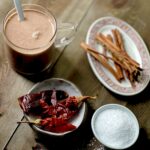“It was the best of times, it was the worst of times…” for Spiked Hot Chocolate!
Charles Dickens has a lot on his mind in 1858. The previous year he met and fell in with 18-year-old Ellen Ternan, an actress in a play he’d co-written with Wilkie Collins. (Dickens was 45.) Since divorce for such a famous person was nearly unthinkable, he had publicly accused his wife of a mental disorder and tried (unsuccessfully) to institutionalize her. They separated and never saw each other again.
He’s also working on his next serialized novel, A Tale of Two Cities. London has become the wealthiest and most powerful urban center in the world. It’s also overcrowded, polluted, riddled with poverty, and rife with disease. Few can remember a hotter summer, and the River Thames overflows with human waste, dead animals, rotting food, and toxic waste from factories, giving rise to what was commonly called the Great Stench.
Dickens needs to escape the heat and stink of the city and take his mind off the troubles in his own life, so he makes his way through the filthy streets of London to his favorite public house.
“What’ll it be, Mr. Dickens?”
“A chocolate,” he replies, thinking of a steaming mug of warmed milk, cocoa, spices, and sugar. (The chocolate bar, incidentally, is only a decade old and has no need as yet to be distinguished from the beverage.) The aroma transports him back less than a century to the time of the French Revolution, when only the elite could afford chocolate and wealthy aristocrats drank it for breakfast. But the innovations of the Industrial Revolution brought drinking chocolate–what we would call “hot chocolate”–to the masses. Dickens muses on this cultural shift and formulates an idea for a satirical scene in which a French aristocrat in the latter half of the 18th century consumes chocolate every morning attended by no less than four lavishly liveried serving men.
Could Charles Dickens imagine that some of his greatest work lies just around the corner?
Ancient Source, Modern Expression
Chocolate is a New World product, dating back several millennia to Mesoamerica where the Aztecs, the Mayans, and possibly earlier cultures consumed it. They served the drink cold, combining a paste made from cocoa seeds with water, cornmeal, chili peppers, and other ingredients. It was spicy and bitter, a far cry from the post-sledding, marshmallow-topped sweet concoction we think of as a winter treat today.
The now-ubiquitous packets of cocoa mix are readily available and combine with hot water to satisfy our need for instant gratification. But it’s worth taking a few extra minutes to prepare hot chocolate with milk and other ingredients for a truly luscious libation. Add alcohol, and hot chocolate returns to the realm of the adult beverage. Toss in some chili powder, cayenne pepper, and other aromatic spices, and you’ve got a modern cocktail with a nod to its Mesoamerican roots. We adapted this recipe from punchdrink.com.
Print
Spiked Hot Chocolate
Description
A Dickensian era delight, for the best of times and the worst of times.
Ingredients
- 3 cups whole milk
- 4 fingers or wedges of Mexican chocolate, available online or in the Mexican section of your supermarket*
- 1 tbsp brown sugar
- 1/8 tsp cayenne pepper
- 1/8 tsp ancho chili powder
- ½ tsp ground cinnamon
- ½ tsp vanilla extract
- 1 cup tequila blanco
- 4 cinnamon sticks or 4 whole dried ancho chilis for garnish
Instructions
- Combine the milk, chocolate, brown sugar, cayenne, chili powder, cinnamon, and vanilla in a saucepan over medium heat, whisking until the chocolate dissolves. It may take five minutes or longer.
- Watch to make sure the milk doesn’t boil over. Pour two ounces of tequila into each of four mugs and add the hot chocolate when it’s heated through.
- Garnish with a cinnamon stick or a whole dried chili.
Notes
- Mexican chocolate comes in bar or disc form. One finger from the bar or a wedge from the disc is a single serving. Increase the number of segments for a more intense chocolate flavor.
- Create a richer hot chocolate by replacing up to half the milk with heavy cream. The velvety smoothness is arguably worth the clogged arteries.
- If you’re not into the heat of peppers, try leaning into more aromatic spices such as cardamom, allspice, nutmeg, or star anise. You can put the whole spices in the pan with the milk and strain them out later or grind the spices into a fine powder before combining them with the milk.
Story by Lindel Hart / Photography by Carol Valle
Subscribe to TABLE Magazine’s print edition.
